Notes
La madera en el arte taino de Cuba
Created by Miguel Sague Jr Aug 22, 2024 at 2:46am. Last updated by Miguel Sague Jr May 5.
AKWESASNE NOTES history
Created by Miguel Sague Jr Jun 12, 2023 at 4:15pm. Last updated by Miguel Sague Jr Jun 12, 2023.
registration form art all night Pittsburgh
Created by Miguel Sague Jr Apr 17, 2023 at 10:58am. Last updated by Miguel Sague Jr Apr 17, 2023.
Events
The Meaning of Autumn Equinox
Takaji My Relatives
In behalf of myself, my family and the whole Caney Indigenos
Spiritual Circle community I want to wish all of you a blessed
Autumnal Equinox.
This season represents a special stage in the ceremonial cycle of
the cemies as seen from the perspective of the Caney Spiritual
Circle. We believe that Yoka Hu, the male spirit of Energy and Life has a Life-Cycle just like any living entity. We believe that YokaHu is born of his Earth-and-Water Mother, Ata Bey, at Spring
Equinox. He rises to full maturity and strength at Summer Solstice
and then decilnes during the stormy, hurricane-blown weeks at the
end of the summer season to finally die at the Autumnal (Fall)
Equinox.
The fact that the ancient Tainos were keenly interested in the transition of the four seasonal high- points including Autumnal Equinox is evidenced by the work of scholar Angel Rodriguez in Caguana Ceremonial Center
The Autumnal Equinox represents the moment when our beloved Life
Spirit, Yoka Hu begins his journey to the realm of the dead. He
descends to the watery underworld at the center of Ata Bey's womb
called "Coa Bay", a place that can be accessed spiritually through
sacred caves. Yoka Hu goes there to be finally re-united as a
germinal embryonic being with his mother's uterus.
The watery realm of Coa Bay is also associated with the round spherical interior of the tropical higuera gourd.
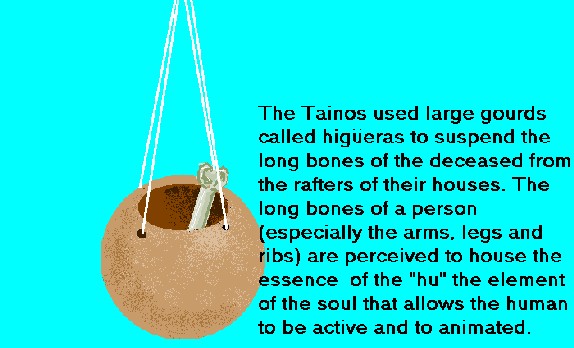
An ancient Taino legend in which the bones of a dead youth interred in a gourd turn into sea-water and fish indicates the way in which ancient Tainos identified the higuera with the watery underworld womb of Mother Earth.
At Winter Solstice, this powerful male spirit overcomes the rigors of Death
and Hardship that characterizes the hurricane-driven late Summer and
Fall. There he awaits rebirth during the dry Winter months, a period
of time which, in the Caribbean, hold very little rainfall and
constrain the ability for plant-life to regenerate. Finally in the
Spring Equinox Yoka Hu is re-born from his mother's womb and the
cycle begins all over again.
We in the Caney Circle recognize two major ceremonial dates during
this season of Yoka Hu's transition and crossing-over:
The first ceremonial date is the date of Fall Equinox itself,
usually around the 20th or 21st of September. That is the actual
date when Yoka Hu dies and crosses over. Yoka Hu is an agricultural
plant spirit (his name means "Soul of the Yuca Plant"), a spirit
that represents the natural life-cycle of a plant, from cultivation
to harvest. The soul of the Taino's most important food item, Yoka
Hu, is the very spiritual manifestation of LIFE itself because Life
depends on the success of the yuca harvest. When the yuca plant is
harvested it dies and in death it manifests its ultimate destiny, to
feed the people. This moment of destiny is actually the
manifestation of sacred personal sacrifice, a concept that plays a
very important role in ancient Taino spirituality. The fact that the
living of one generation eventually die to contribute to the success
of the life of the next generation is a central ideological concept
in the cyclical configuration of the spiritual mentality of our
ancestors. We honor our Lord Yoka Hu on this day for his personal
sacrifice and thank our Lady Ata Bey for her generosity in offering
us the product of her ever-fertile womb, the nurishing gift of
divine Life, the fruits of another year's harvest. During this
season of storm and death we recognize the fact that the sacred
cycle is completed and that this completion, harsh as it may seem,
is the moment when the slate is wiped clean to make room for a new
story, a new adventure of Life and Energy.
During Autumn Equinox Ceremony we honor the Cosmic Matriarch AtaBey by recognizing her totem animal the boa constrictor serpent. We know that our Taino ancestors demonstrated their devotion to Atabey by creating representations of the serpent spirit in their art.
It is the time of sacrifice when the plant spirits give up their lives at harvest time that we may live. It is the time when we look forward to the celebration of the ancestors in November’s Day of the Dead.
The Equinox Ceremony is primarily a woman’s ritual. Whenever possible it should be led by a female beike, and a woman chosen from the participants to represent the presence of Ata Bey among the people should play a very prominent role.
A woman is chosen from the participants of a Caney ceremony to represent Ata-Bey and crowned with the headress of the Cosmic Matriarch.
The ceremony begins with all the participants male and female in a large circle to perform the tobacco ritual. After the smoking ceremony is performed the men and the women separate. The men remain at the main ceremonial site and the women withdraw to another place to perform the women’s ritual.
The women’s ritual begins with all the women sitting together in a circle including the woman who is playing the role of Ata Bey. A container holding red or orange face paint made of annatte seeds (achiote) or (bija) is passed around the circle of women. The red face paint is used by each individual woman to create her own personal spirit design on her face.
When all the women have painted their faces the woman who plays the role of Ata-Bey stands and is led to the middle of the circle where she sits.
A rig is prepared beforehand and attached to the ceiling or the branch of a tree. This rig should be a wide loop or ring of some kind that can allow a fairly wide rope to be run through it. The most important aspect of this part of the ceremony is the creation of a long snake-like structure made out of ropes.
The rope weaving ritual is derived from an Indigenous dance traditionally performed in a region of Venezuela, a country with a large Arawakan native population and the home of the Orinoco River where the ancestors of the ancient Taino originated. The Venezuelan dance consists of performers who move in two concentric circles dancing in opposite directions holding on to ribbons. As the dancers move the ribbons are woven into a snake-like cylinder that resembles the woven palm-leaf tubes used by the yuca-cultivating Natives to manufacture casabe bread. This cylindrical woven object is called "sebucan" by the Venezuelans and was called "cibucan" by the ancient Tainos.
The Caney Circle Serpent dance serks to create a symilar woven structure out of ropes. This is achieved by hanging one end of the rope through the loop rigging and allowing the other end to trail down in a big handful of strands that will then be taken individually by the women participants.
Each woman takes the end of one of the ropes. The end of each rope is coiled around a stick to create a large rope bundle which the woman holds in her hand. Then all the participants form a large circle around the woman that has been chosen to represent Ata-Bey. The behike takes the other end of the rope assemblage and pulls gently against the pull of the participants to keep all the ropes taut. At this point the Boa constrictor dance chant begins and the participants begin to dance around the Ata-Bey woman.
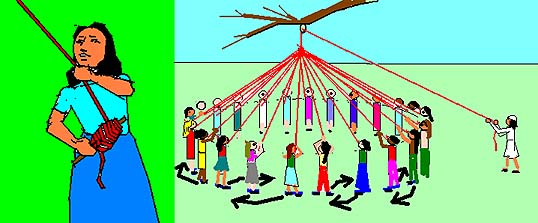
women's boa dance 1
As the body of the rope serpent is created by the weaving motion of the women’s dance the behike gradually pulls in her end of the rope through the loop that hangs above he celebrants. At the same time the large ball of wound-up rope in the hands of each celebrant grows gradually smaller as the dance progresses
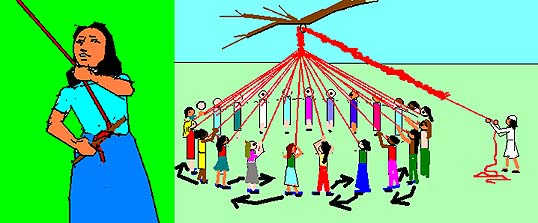
women's boa dance 2
The participants dance in two different directions. The direction that each woman is going to dance is decided at the beginning. Just before the beginning of the dance they are given the opportunity to state their position in the circle by calling out the words “I can make” and “I can un-make” alternatively. One woman is chosen to be the first and she says “I can make”, expressing Ata-Bey’s power to create. The next woman calls out “I can un-make”, expressing Mother Nature’s formidable transformative power to change the face of the Earth. The next woman then calls out “I can make” and the next calls out “I can unmake” and so on until every woman knows whether she is a maker or an un-maker. When the dance begins the “makers” dance in a clock-wise direction and the “un-makers” dance in a counter-clockwise direction weaving in and out of each other.

As the weaving motion of the women’s dance creates the thick rope body of the ceremonial boa constrictor snake, the point at which all the ropes come together gradually descends dangerously close to the top of Ata-Bey’s head.
So the behike calls a halt to the dance and begins to pull on her end of the rope snake through the loop. As she pulls all the women allow her some slack by letting some length of rope to go forth from their individual rope coils. This causes the point where the ropes come together to rise away from the top of Ata-Bey’s head.
The dance can begin again as the women continue their weaving motion to further the length of the rope snake. When the point where the ropes come together again reaches down too close to Ata Bey’s head the behike again stops the dance and again the ropes are pulled through the loop. This process continues until most of the length of the ropes have been woven into the body of the snake.
Once the behike decides that she or he feels the woven rope is long enough the snake is declared completed and it is brought down from its loop and spread out. One end of it is tied to stuffed head of a snake effigy or if one of those is not available then it is attached to the belt of Ata-Bey and the women line themselves all along the length of it in a single file holding on to it with their hands.
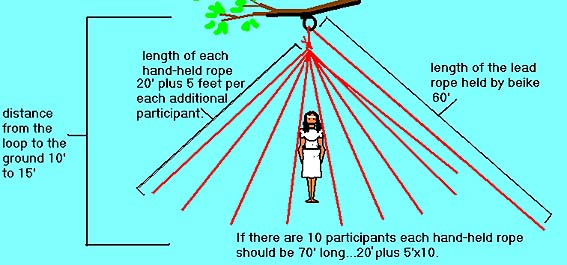
Measurements of all the ropes used in the Boa Constrictor Dance
The moment arrives when the participants have lined themselves up all along the length of the rope serpent
Behind the row of participants holding on the the rope snake there should be four women, each one representing one of the four directions and each one holding a basket filled with the particular food associated with her direction within our Caney tradition. These are the FOOD MOTHERS. and they represent The South with it’s green squash, the West with its black beans, the North with its white cassava loaves, and the East with its yellow grains of maize-corn.
At this point the Boa Constrictor dance chant begins and the long row of women begin to dance forth from the place where they were for their women’s ritual and toward the main ceremonial center where the men await them. Resplendent in their face-paint and lined up all along the length of the rope snake they wind their way toward the men’s group led by the woman that represents Ata-Bey who is guided by two of the participants and by the behike. The behike should dance alongside the leader chanting and playing her drum or rattle all the way to the men’s group. The men should at this point form themselves into a circle facing out.
When the women reach the men’s hoop, they circle around them in a line all along the rope snake. Once they have encircled the men’s hoop the rope snake is gathered up by the behike. The women each stands face to face with one or more men. The women then paint sacred designs on the faces of the men thereby bringing the blessing of the women’s ceremony to the male participants. If there are more men than women some of the women paint more than one man’s face. If there are more women than men then some men will allow themselves to have their faces painted by more than one woman.
When all the men’s faces are painted the women and the men form one big circle and begin to dance together.
After dancing together for a while the dance is stopped by the behike. During Fall Equinox the ceremony ends here.
The second ceremonial date that emerges during the Fall season takes
place at the beginning of November, on a date that we now call "DAYOF THE DEAD".
That day signals a moment when the living render
respect and tribute to those who have made the same journey upon the
same road that Yoka Hu now finds himself, to the realm of Coa Bay.
On the holiday of Day of The Dead we honor the ancestors and other
departed loved ones who dwell in Coa Bay. We eat guayaba (guava
fruit) in all of its manifestations. We offer the guayaba fruit to
the hupias (spirits of the dead) by putting bits of guava or guava
paste in front of the memory tablets that we keep to honor our
departed ones. Memory tablets, as maintained by followers of the
Caney Spiritual Circle, are small vertical wooden boards which
support a shelf on the lower end and a hook at the upper end.
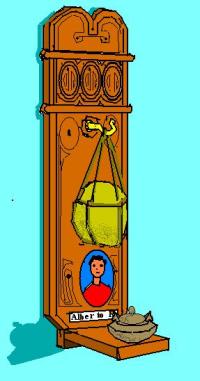
The shelf on the lower end of these wooden boards in turn support a tiny
clay bowl that represents the clay bowls that ancient Taino people
used to bury the skull of their dead relatives under their houses.
The hook at the top of the memory board supports the set of cords
from which is suspended a tiny gourd that represents the gourds used
by the ancient Taino to hang the long bones of their dead relatives
from the rafters of their homes.
Taino Ti
Miguel Sobaoko Koromo Sague
Comment
-
Comment by Miguel Sague Jr on September 20, 2016 at 12:33pm
© 2025 Created by Network Financial Administration.
Powered by
![]()

You need to be a member of Indigenous Caribbean Network to add comments!
Join Indigenous Caribbean Network